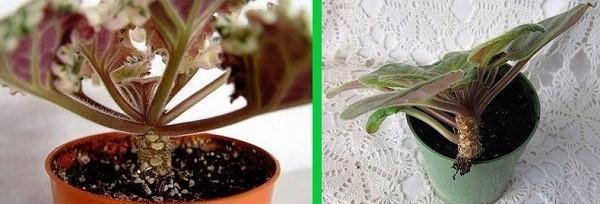We rejuvenate the old violet or why the flower is "blown off its head"
 Not only people, but also flowers become adults and grow old over time. This is the case with violets: while the plant is young, it actively grows deciduous mass, blooms and forms children. Outwardly, the bush looks very beautiful - it is lush, there are so many leaves that sometimes you cannot even see the soil under them.
Not only people, but also flowers become adults and grow old over time. This is the case with violets: while the plant is young, it actively grows deciduous mass, blooms and forms children. Outwardly, the bush looks very beautiful - it is lush, there are so many leaves that sometimes you cannot even see the soil under them.
But it often happens that a completely healthy violet bare the stem, becomes not very attractive and looks more like a palm tree - on a high bare trunk, the leaves are located only at the top. The reason for this phenomenon can be both the venerable age of the plant and human intervention, when the lower tier of old leaves breaks off all the time.
Rejuvenation methods
Be that as it may, if the violet is healthy, you should not immediately throw it away, because it is quite possible to return the flower to its previous appearance. This can be done in two ways, depending on how much the trunk is exposed:
- Transplant completely... If a violet it did not stretch significantly, it just needs to be transplanted, but with one condition - when planting, the entire bare trunk should be deepened into the soil. Thus, new, additional, roots will grow on it, which will feed the upper part of the bush and after a while young leaves will form on it.
- Cut off and root the top... This method is used if the trunk is very exposed and elongated.
Renewal of a violet with a cut top
With a transplant, in principle, everything is clear, but how is it correct to "take off the head of a violet"? After all, this is a serious interference, and if you do something wrong, you can ruin the flower.
So, first of all, you need to completely cut off the violet at ground level with a sharp knife at one time, without getting it out of the flowerpot.
Before use, the knife must be disinfected - wiped with alcohol.
Now clean the lower part of the bare trunk from stumps and dry scales, scraping them with a knife, like the peel of a carrot, until living tissue appears.
Put expanded clay at the bottom of the pot and fill it with a light nutritious mixture. Moisten the soil, make a depression in the center and simply insert the cut "head" of a violet into it. Tighten a little so that it does not wobble.
If the procedure is carried out in the summer, it is better to put the violet for rooting in a glass of water, since it will simply cook in the greenhouse.
The planted top must be placed in a greenhouse so that it grows roots faster. This will take about two weeks, during which it is necessary to periodically ventilate the greenhouse and moisten the ground. When the violet is rooted, it can be placed on the windowsill.